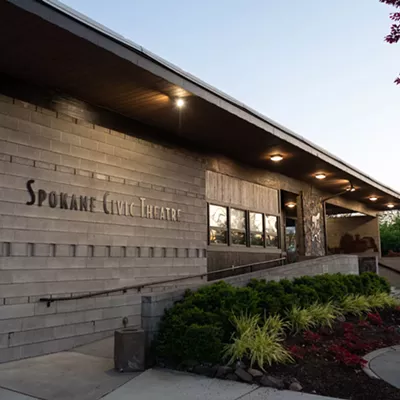What can I say? I dig the underground. Whether it's speakeasies, steam tunnels or cult films, I very much like it in the dark. My current obsession with fallout shelters was ignited by the sight of a faded shelter sign on the exterior of a medical building near Sacred Heart Hospital. My search for fallout shelter evidence began with a map I picked up at a garage sale -- the 1969 edition of Spokane County's Community Shelter Plan. Though every sturdy brick or concrete structure with a basement in this town is suspect, the map tells you exactly where they were located and gives you their occupancy levels. The shelter in the Zukor Building on Riverside could hold just 31 survivors. The Bon Marche building had the largest capacity of all: 17,998. It was judged sturdy enough to hold people throughout its levels. (I guess nobody figured the blast could break windows.)
Then there were the supplies. A fully stocked fallout shelter in the 1960s would have included the following:
Water came in 24-inch tall, 17.5-gallon steel containers. The survival ration was one quart of water per person per day for two weeks. The steel containers were to be used as chemical toilets after the water was consumed.
Food came in the form of tins of crackers, biscuits, bulgur wafers and carbohydrate supplement (hard candy). The survival ration was 700 calories per person per day for two weeks.
Sanitation kits consisted of 22-inch-tall fiberboard drums, which contained plastic cups, toilet paper, sanitary napkins, toilet chemical packets, waterless hand-cleaning solution, plastic toilet liner bags and plastic gloves. They were meant to serve as the initial chemical toilet until the water drums were emptied and became available.
Medical supply kits typically contained such first aid supplies as aspirin, laxatives, antacid, isopropyl alcohol, penicillin, surgical soap, water purification tablets, petrolatum, bandages, gauze and a thermometer.
Radiation detection kits were provided for every 50-1,000 shelter spaces and included radiometers (which measured radiation levels) and dosimeters (which measured accumulated radiation doses over time). These would have likely shown survivors that the world to which they planned to return had been badly poisoned. Despite surviving the initial attack, their days would have been numbered.
From the outset of this investigation, I surmised that my chances of finding a fully stocked fallout shelter in Spokane, in 2004, were probably slim to none. After all, national commitment to the concept of nuclear attack preparedness and survival dropped off dramatically in the 1970s as icy relations between the United States and the Soviet Union began to thaw. In other words, it's been almost 30 years since anyone gave a hoot about fallout shelters. Adding to those concerns was Thomas Mattern, deputy director for the Spokane City/County Department of Emergency Management, who told me the shelter program was more than just officially abandoned.
"In the late '70s, they actually dismantled them, so that today, there are no longer any stocked fallout shelters," he says.
But I went out anyway -- and almost immediately hit paydirt. As it stands right now, I'm 3-for-3. Of the three basements I've actually visited in downtown Spokane, I've turned up evidence of fallout shelters in each one (the Met Theater, the Madison Apartments and Jensen Distributing). Granted, my list was gleaned from the Community Shelter Plan and was whittled down to what my instincts told me were the most likely suspects, but still. Not a bad score.
In the bowels of the Met, general manager Michael Smith and I discovered a single (unused) sanitation kit, along with a spot on the basement wall where a fallout shelter sign used to be ("I think those all disappeared after the Alice in Chains concert," he grumbled). In the boiler room of the New Madison Apartments, property owner Michael Dennis and I found five Army green water barrels, four of which still had their liners and water supplies intact. The water barrels in the basement of Jensen Distributing had long ago been converted to trash cans.
Well then, that's seven water barrels, one sanitation kit and a smattering of black and yellow shelter signs (outside of various buildings around town). But where are the medical kits, the food rations, the radiometers and dosimeters? These remain, for now, elusive.
If anyone out there reading this knows of a stocked fallout shelter or, better yet, a home fallout shelter in the Spokane area, I'd very much like to know about it. Contact me at mike@inlander.com or 509-325-0634 ext. 234. Next stop: the basement of the Masonic Temple. Wish me luck.
Publication date: 05/20/04














